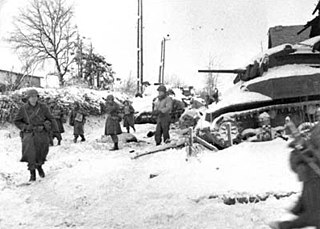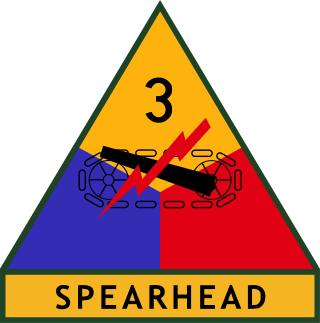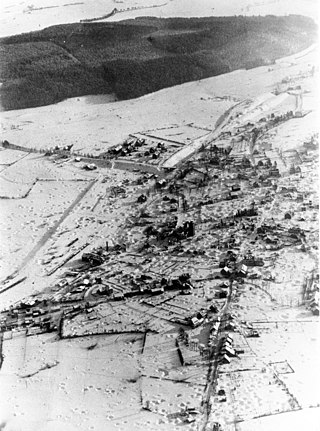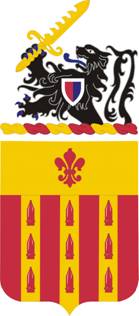
The Battle of the Bulge, also known as the Ardennes Offensive, was the last major German offensive campaign on the Western Front during World War II. The battle lasted for five weeks from 16 December 1944 to 28 January 1945, towards the end of the war in Europe. It was launched through the densely forested Ardennes region between Belgium and Luxembourg. It overlapped with the Alsace Offensive, subsequently the Colmar Pocket, another series of battles launched by the Germans in support of the Ardennes thrust.

The Malmedy massacre was a German war crime committed by soldiers of the Waffen-SS on 17 December 1944 at the Baugnez crossroads near the city of Malmedy, Belgium, during the Battle of the Bulge. Soldiers of Kampfgruppe Peiper summarily killed eighty-four U.S. Army prisoners of war (POWs) who had surrendered after a brief battle. The Waffen-SS soldiers had grouped the U.S. POWs in a farmer's field, where they used machine guns to shoot and kill the grouped POWs; the prisoners of war who survived the gunfire of the massacre then were killed with a coup de grâce gun-shot to the head.

The 3rd Armored Division was an armored division of the United States Army. Unofficially nicknamed the "Third Herd", the division was first activated in 1941 and was active in the European Theater of World War II. The division was stationed in West Germany for much of the Cold War and also participated in the Persian Gulf War. On 17 January 1992, still in Germany, the division ceased operations. In October 1992, it was formally inactivated as part of a general drawing down of U.S. military forces at the end of the Cold War.

The 17th (Northern) Division was an infantry division of the British Army, a Kitchener's Army formation raised during the Great War.

The 87th Infantry Division was a unit of the United States Army in World War I and World War II.

The 84th Training Command ("Railsplitters") is a formation of the United States Army. During World War I it was designated the 84th Division, American Expeditionary Forces; during World War II it was known as the 84th Infantry Division. From 1946 to 1952, the division was a part of the United States Army Reserve as the 84th Airborne Division. In 1959, the division was reorganized and redesignated once more as the 84th Division. The division was headquartered in Milwaukee in command of over 4,100 soldiers divided into eight brigades—including an ROTC brigade—spread throughout seven states.

The 86th Infantry Division, also known as the Blackhawk Division, was a unit of the United States Army in World War I and World War II. Currently called the 86th Training Division, based at Fort McCoy, Wisconsin, members of the division now work with Active Army, Reserve, and National Guard units to provide them with a Decisive Action Training Environment on a yearly basis.

The 106th Infantry Division was a division of the United States Army formed for service during World War II. Two of its three regiments were overrun and surrounded in the initial days of the Battle of the Bulge, and they were forced to surrender to German forces on 19 December 1944. The division was never officially added to the troop list following the war, despite having been almost completely organized in Puerto Rico by 1948; subsequently, the War Department determined the division was not needed and inactivated the division headquarters in 1950.

The 27th Infantry Division was a unit of the Army National Guard in World War I and World War II. The division traces its history from the New York Division, formed originally in 1908. The 6th Division designation was changed to the 27th Division in July 1917.

The 1st SS Panzer Division Leibstandarte SS Adolf Hitler or SS Division Leibstandarte, abbreviated as LSSAH, began as Adolf Hitler's personal bodyguard unit, responsible for guarding the Führer's person, offices, and residences. Initially the size of a regiment, the LSSAH eventually grew into an elite division-sized unit during World War II.

The Battle of Losheim Gap was fought in the Ardennes, in Eastern Belgium, between the Allies and Nazi Germany, part of the Battle of the Bulge. It was the first battle and spearhead of the German attack, inflicting heavy American casualties, and causing disorder on the frontlines. It paved the way for further German attacks, deeper into the Ardennes. The Americans suffered high casualties, but could replace them. The Germans, on the other hand, couldn't replace their men, as all reserves were directed to the counter offensive. This reflected the poor state that the German Army was in at this time, which would be the precedent for the following battles.
The 969th Field Artillery Battalion was an African American United States Army field artillery unit that saw combat during World War II. The battalion landed at Utah Beach during Operation Neptune, and participated in the liberation of France and Belgium. Along with survivors of the 333rd Artillery Battalion, it gave fire support to the 101st Airborne Division during the siege of Bastogne. Because of the heavy losses suffered by the 333rd, some of its remaining members were reassigned to the 969th Field Artillery Battalion after the Battle of the Bulge.
Gustav Knittel was a Sturmbannführer (major) in the SS Division Leibstandarte (LSSAH) who was awarded the Knight's Cross of the Iron Cross. Sentenced to life imprisonment for ordering the illegal executions of 8 American prisoners of war, he was released in 1953.

The 106th Cavalry Regiment was a mechanized cavalry unit of the United States Army in World War II recognized for its outstanding action. The group was organized in 1921 as part of the Illinois National Guard and during the Spanish–American War and World War I was known as the 1st Regiment Illinois Volunteer Cavalry. It underwent a number of reorganizations before World War II. Like other Guard units during the inter-war years, the 106th held weekly or monthly drills and yearly training. Readiness for war in 1940 led to the mechanization of the unit and induction into Federal service at Camp Livingston, Louisiana on 25 November 1940.

This is a sub-article to Leningrad–Novgorod Offensive and Battle of Narva.

The Battle of St. Vith was an engagement in Belgium fought during the Allied advance from Paris to the Rhine in World War II. It was one of several battles on December 16, 1944 constituting the opening of Germany's Ardennes counteroffensive.

The 319th Field Artillery Regiment, more commonly referred to as the 319th Airborne Field Artillery Regiment, is a parent regiment in the U.S. Army Regimental System. Four battalions of the regiment are currently active. The first three battalions 1st Battalion, 319th Field Artillery Regiment, 2nd Battalion, 319th Field Artillery Regiment, 3rd Battalion, 319th Field Artillery Regiment are in the 82nd Airborne Division and the 4th Battalion, 319th Field Artillery Regiment is in the 173rd Airborne Brigade.

The 333rd Field Artillery Regiment is a regiment of the Field Artillery Branch of the United States Army.

The 1st Battalion, 108th Field Artillery Regiment, 56th Stryker Brigade Combat Team, is the only direct support field artillery battalion in the only National Guard Stryker Brigade in the United States Army.
The 333rd Rifle Division began forming in the North Caucasus Military District in August, 1941, as a standard Red Army rifle division, as part of the massive mobilization of reserve forces very shortly after the German invasion. In 1942 it served in the late winter and early spring fighting near Kharkov, taking a beating both then and during the opening stages of the German summer offensive. Withdrawn into the reserves, the division was rebuilt in time to take part in the Soviet counteroffensive at Stalingrad in November, and played an important role in driving the German forces out of the Caucasus region during the winter. In the autumn of 1943 the division shared credit with the 25th Guards Rifle Division for the liberation of Sinelnikovo in the Dnipropetrovsk Oblast, receiving that place name as an honorific. After battling through Ukraine and into the Balkan states, the 333rd completed its combat path on a relatively quiet note doing garrison duties in the Balkans.



















